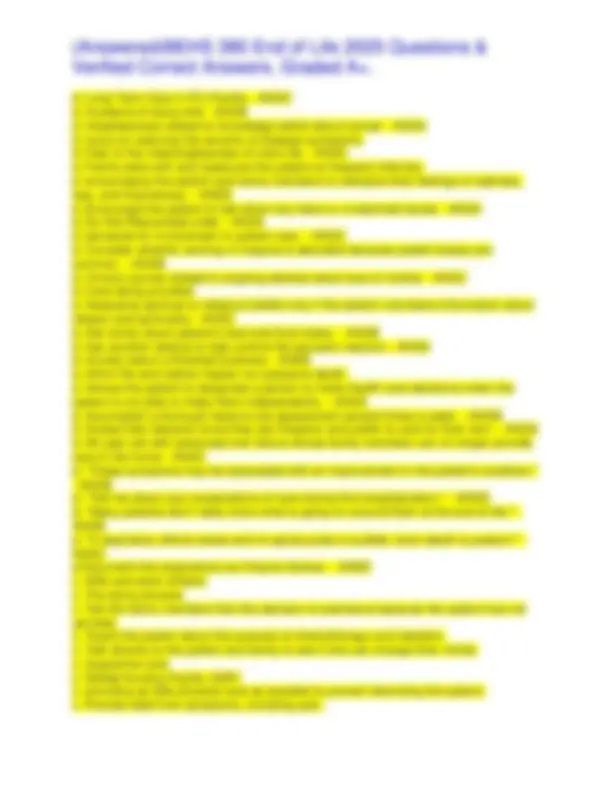







Study with the several resources on Docsity

Earn points by helping other students or get them with a premium plan


Prepare for your exams
Study with the several resources on Docsity

Earn points to download
Earn points by helping other students or get them with a premium plan
Community
Ask the community for help and clear up your study doubts
Discover the best universities in your country according to Docsity users
Free resources
Download our free guides on studying techniques, anxiety management strategies, and thesis advice from Docsity tutors
BEHS 380 End of Life 2025 Questions & Verified Correct Answers1...pdf
Typology: Exams
1 / 9

This page cannot be seen from the preview
Don't miss anything!






While taking routine vital signs on a palliative care unit, a client suddenly begins to weep, telling the nurse that "I know my cancer is punishment for the things I did when I was younger". The nurse would best support the client by: While caring for his dying wife, the husband states that his wife is a devout Roman Catholic but he is a Baptist. Who is considered the most reliable source for spiritual preferences concerning EOL care for the dying wife? Which patient should the nurse refer for hospice care? Which nursing actions for the care of a dying patient can the nurse delegate to a licensed practical/vocational nurse (LPN/LVN) (select all that apply)? Which care setting is most appropriate to initially transition an 88-year-old hospitalized stroke patient with a stage III sacral pressure ulcer requiring physical and occupational therapy? Which action is best for the nurse to take to ensure culturally competent care for an alert, terminally ill Filipino patient? The spouse of a patient with terminal cancer visits daily and cheerfully talks with the patient about wedding anniversary plans for the next year. When the nurse asks about any concerns, the spouse says, "I'm busy at work, but otherwise things are fine." Which nursing diagnosis is most appropriate? The son of a dying patient tells the nurse, "Mother doesn't really respond any more when I visit. I don't think she knows that I am here." Which response by the nurse is appropriate? The primary purpose of hospice is to The nurse cares for an adolescent patient who is dying. The patient's parents are interested in organ donation and ask the nurse how the decision about brain death is made. Which response by the nurse is most appropriate? The nurse cares for a terminally ill patient who is experiencing pain that is continuous and severe. How should the nurse schedule the administration of opioid pain medications? The nurse cares for a terminally ill patient who has 20-second periods of apnea followed by periods of deep and rapid breathing. Which action by the nurse would be most appropriate? The nurse cares for a patient with lung cancer in a home hospice program. Which action by the nurse is most appropriate? The nurse admits a terminally ill patient to the hospital. What is the first action that the nurse should complete when planning this patient's care? The husband and daughter of a Hispanic woman dying from pancreatic cancer refuse to consider using hospice care. What is the first thing the nurse should do? The home health nurse visits a 40-year-old patient with metastatic breast cancer who is receiving palliative care. The patient is experiencing pain at a level of 7 (on a 10-point scale). In prioritizing activities for the visit, the nurse would do which first? The family attorney informed a patient's adult children and wife that the patient did not have an advance directive after she suffered a serious stroke. Who is responsible for making the decision about EOL measures when the patient cannot communicate his or her specific wishes?
The dying patient and family have many interrelated psychosocial and physical care needs. Which ones can the nurse begin to manage with the patient and family (select all that apply)? The children caregivers of an elderly patient whose death is imminent have not left the bedside for the past 36 hours. In the nurse's assessment of the family, what findings indicate the potential for an abnormal grief reaction to occur (select all that apply)? In most states, directives to physicians, durable power of attorney for health care, and medical power of attorney are included in which legal documents? In discussing end of life care with a terminally ill patient, the nurse explains that in a hospice program: i. Offer support to the family during the patient's illness and their own bereavement. - ANS-A, C, D, F, G, I h. Assist the patient and family to identify and access pastoral care services. g. Offer support to patients to live as actively as possible until death. For the past 5 years Tom has repeatedly asked his mother to donate his deceased father's belongings to charity, but his mother has refused. She sits in the bedroom closet, crying and talking to her long-dead husband. What type of grief is Tom's mother experiencing? f. Support holistic patient care and enhance quality of life. f. Feeling powerless and hopeless - ANSA, B, C, D, E, F End-of-life palliative nursing care involves e. Siblings who were estranged from each other have now reunited. - ANSA, C e. provide care that the family is unwilling or unable to give. - ANSA, D e. Prolong the patient's life with aggressive new therapies. e. Anger toward the nurse e. Administer the prescribed morphine sulfate sublingual as necessary for pain control. - ANSA, B, E d. Use any methods that make the patient more comfortable. - ANSD d. This patient should be referred to a clergyman for a discussion of his beliefs. - ANSA d. The new normal stage of the Grief Wheel - ANSB d. Tell the patient that everything possible is being done to delay death. - ANSB d. Teach family members about commonly occurring signs of approaching death. d. Suggest analgesic doses that provide pain control without decreasing respiratory rate. - ANSA d. Remind the family that this should be the patient's decision and to ask her if she regains consciousness. - ANSB d. Remind family members that dying patients prefer to have someone at the bedside - ANSA d. Pruritus - ANSC d. Providing privacy for the client's expression of grief - ANSB d. provide comfort and support for dying patients and their families. - ANSD d. Prolonged grief disorder - ANSD d. Private insurance is accessed for most clients - ANSC d. Physician and nursing staff - ANSC d. Maintenance care - ANSB
c. Pressure ulcers c. patterns for dealing with grief. c. Offer enough pain medication to keep the patient sedated and unaware of stimuli. c. Obtain information from Filipino staff members about possible cultural needs. c. Leave the home as soon as possible to allow the family to grieve privately. c. Kübler-Ross's stage of depression c. Insist that family members remain at the bedside with the patient. c. Inform the patient that a notarized advance directive must be included in the record or resuscitation must be performed. c. Hospice staff c. He needs to be reassured that his feelings are normal. c. have time to teach patient and family about disease. c. Explaining the importance of a peaceful death to the spouse c. Discuss the normal grief process with the patient and family. c. Determine how frequently physical assessments are needed for the patient. c. Decreased decision making c. coordinate care for dying patients and their families. c. Check pressure points for skin breakdown. c. Caregiver role strain related to feeling overwhelmed c. Calling for the facility chaplain c. Bereavement care is provided beyond six months c. Asking about spiritual customs or rituals around illness and death that are meaningful to the patient c. Anxiety related to lack of knowledge about normal grieving c. Anxiety about unfinished business c. Anticipatory grief c. Advance care planning c. Administer antianxiety agents. c. A family member is going through a difficult divorce. c. 28-year-old with AIDS-related dementia who needs palliative care and pain management c. "These symptoms indicate a reflex response to the slowing of other body systems." c. "It will be important for you to stimulate your mother as she gets closer to dying." c. "Do you have any preferences for what happens if you are dying?" c. "Brain death has occurred if there is no breathing and certain reflexes are absent." c Place the patient in high Fowler's position. b. Yearning and protest b. This man most likely will not have a peaceful death. b. Take the family members aside and explain that the patient may be able to hear them. b. Sit at the bedside and ask if there is anything the patient needs. b. Provide PRN doses of medication whenever the patient requests. b. provide better quality of care than the family can. b. Place a "Do Not Resuscitate" (DNR) notation in the patient's care plan. b. Physician and family
b. Pathological fractures b. past feelings toward death. b. Palliative care b. Minimize the financial burden on the family. b. Let the family decide whether to tell the patient about the terminal diagnosis. b. Leading the spouse away to grieve in another room b. Kübler-Ross's stage of bargaining b. Inquiring if the client has a spiritual support person b. Home with home health care services b. Fear of pain b. Encouraging the patient to join a religious community if they do not already belong to one b. Encourage the patient to discuss past life events and their meaning. b. Encourage the family members to talk with and reassure the patient. b. Emphasize the importance of addressing any family issues. b. Dying wife b. Dying patient is becoming more restless and agitated. b. Disruptive grief b. Decreased socialization b. Cry along with the patient's family members. b. Complicated grieving related to unresolved issues b. Care is provided mainly by volunteers b. assess her coping ability with disease. b. Ask them how they will care for the patient without hospice care. b. Anxiety related to complicated grieving process b. Allow natural death b. administering large doses of analgesics to keep the patient sedated. b. Administer PRN pain medication. b. Administer bronchodilators. b. 72-year-old with chronic severe pain as a result of spinal arthritis and vertebral collapse b. "Withdrawal may sometimes be a normal response when preparing to leave life." b. "These symptoms are a normal response before these functions decrease." b. "If CPR is ineffective in restoring a heartbeat, the brain cannot function." b. "Are you interested in learning about palliative or hospice care?" b Administer oxygen via face mask. Assessment of a palliative care patient's spiritual or religious beliefs should encompass which of the following? As the nurse admits a patient in end-stage kidney disease to the hospital, the patient tells the nurse, "If my heart or breathing stop, I do not want to be resuscitated." Which action is best for the nurse to take? As a Hispanic client nears death, the spouse begins to weep and call out loudly at the bedside. The nurse responds by: An 80-year-old female patient is receiving palliative care for heart failure. Primary purpose(s) of her receiving palliative care is (are) to (select all that apply)
a. "If you die, will you want an autopsy?" a. "Brain death occurs if a person is flaccid and unresponsive." A young adult patient with metastatic cancer, who is very close to death, appears restless. The patient keeps repeating, "I am not ready to die." Which action is best for the nurse to take? A terminally ill patient is unresponsive and has cold, clammy skin with mottling on the extremities. The patient's husband and two grown children are arguing at the bedside about where the patient's funeral should be held. What should the nurse do first? A terminally ill man tells the nurse, "I have never believed there is a God or an afterlife, but now it is too terrible to imagine that I will not exist. Why was I here in the first place?" What does this comment help the nurse recognize about the patient's needs? a Suction the patient. A patient with end-stage liver failure tells the nurse, "If I can just live to see my first grandchild who is expected in A patient who has been diagnosed with inoperable lung cancer and has a poor prognosis plans a trip across the country "to settle some issues with sisters and brothers." The nurse recognizes that the patient is manifesting which psychosocial response to death? A patient is receiving care to manage symptoms of a terminal illness when the disease no longer responds to treatment. What is this type of care known as? A patient in the last stages of life is experiencing shortness of breath and air hunger. Based on practice guidelines, what is the most appropriate action by the nurse? A nurse has been working full time with terminally ill patients for 3 years. He has been experiencing irritability and mixed emotions when expressing sadness since four of his patients died on the same day. To optimize the quality of his nursing care, he should examine his own A middle-aged patient tells the nurse, "My mother died 4 months ago, and I just can't seem to get over it. I'm not sure it is normal to still think about her every day." Which nursing diagnosis is most appropriate? A hospice patient is manifesting a decrease in all body system functions except for a heart rate of 124 and a respiratory rate of 28. Which statement, if made by the nurse to the patient's family member, is most appropriate? A hospice nurse who has become close to a terminally ill patient is present in the home when the patient dies and feels saddened and tearful as the family members begin to cry. Which action should the nurse take at this time? A home hospice patient becomes progressively less mobile and is ultimately bed- bound. A common complication of immobility in the palliative care patient is: A deathly ill patient from a culture different than the nurse's is admitted. Which question is appropriate to help the nurse provide culturally competent care? A 67-year-old woman was recently diagnosed with inoperable pancreatic cancer. Before the diagnosis she was very active in her neighborhood association. Her husband is concerned because his wife is staying at home and missing her usual community activities. Which common EOL psychologic manifestation is she most likely demonstrating?
5 months, then I can die happy." The nurse recognizes that the patient is demonstrating which of the following stages of grieving?